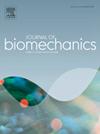Comparison of markerless and marker-based motion analysis accounting for differences in local reference frame orientation
IF 2.4
3区 医学
Q3 BIOPHYSICS
引用次数: 0
Abstract
Markerless motion analysis offers a promising alternative to traditional marker-based motion capture. Differences between the kinematic signals obtained with these systems have been reported, but the hypothesis that these differences stem from reference frame alignment inconsistencies has not been systematically assessed. This study aims to apply a reference frame alignment method (REFRAME) to markerless captured knee kinematic signals to determine if inconsistencies with marker-based results are related to differences in local frame orientation. Ten healthy subjects (5/5 M/F, age 26.8 ± 5.6 years, 21.5 ± 1.8 kg/m2) were recruited to perform five walking trials each. Data was simultaneously recorded using eight video cameras (Miqus, Qualisys) for the markerless capture system (Theia3D), and twenty-four cameras (Oqus and Arqus, Qualisys) for the marker-based system (Qualisys). Both sets of processed data were exported for kinematic analysis in Visual3D (C-Motion). Implementing the REFRAME approach optimized the markerless kinematic signals towards the marker-based system, resulting in an average rotation of the tibia coordinate system of 13.8° ± 3.1° and 4.9° ± 3.6° around the y- and z-axes, respectively, and 5.3° ± 2.8°, 5.8° ± 2.4°, and 7.9° ± 4.9° for the femur coordinate system around the x-, y-, and z-axes, respectively. Post-REFRAME results showed improved agreement between markerless and marker-based data in all three planes. The root-mean-square error decreased from 3.9° ± 1.5° to 1.7° ± 0.2° (sagittal plane), from 6.1° ± 1.3° to 1.7° ± 0.3° (frontal plane), and from 10.2° ± 2.8° to 2.5° ± 0.5° (transverse plane). These findings indicate that most of the differences between markerless and marker-based data are likely due to inconsistencies in local frame orientations, suggesting that markerless kinematic signals represent fundamentally similar underlying motion waveforms.
求助全文
约1分钟内获得全文
求助全文
来源期刊

Journal of biomechanics
生物-工程:生物医学
CiteScore
5.10
自引率
4.20%
发文量
345
审稿时长
1 months
期刊介绍:
The Journal of Biomechanics publishes reports of original and substantial findings using the principles of mechanics to explore biological problems. Analytical, as well as experimental papers may be submitted, and the journal accepts original articles, surveys and perspective articles (usually by Editorial invitation only), book reviews and letters to the Editor. The criteria for acceptance of manuscripts include excellence, novelty, significance, clarity, conciseness and interest to the readership.
Papers published in the journal may cover a wide range of topics in biomechanics, including, but not limited to:
-Fundamental Topics - Biomechanics of the musculoskeletal, cardiovascular, and respiratory systems, mechanics of hard and soft tissues, biofluid mechanics, mechanics of prostheses and implant-tissue interfaces, mechanics of cells.
-Cardiovascular and Respiratory Biomechanics - Mechanics of blood-flow, air-flow, mechanics of the soft tissues, flow-tissue or flow-prosthesis interactions.
-Cell Biomechanics - Biomechanic analyses of cells, membranes and sub-cellular structures; the relationship of the mechanical environment to cell and tissue response.
-Dental Biomechanics - Design and analysis of dental tissues and prostheses, mechanics of chewing.
-Functional Tissue Engineering - The role of biomechanical factors in engineered tissue replacements and regenerative medicine.
-Injury Biomechanics - Mechanics of impact and trauma, dynamics of man-machine interaction.
-Molecular Biomechanics - Mechanical analyses of biomolecules.
-Orthopedic Biomechanics - Mechanics of fracture and fracture fixation, mechanics of implants and implant fixation, mechanics of bones and joints, wear of natural and artificial joints.
-Rehabilitation Biomechanics - Analyses of gait, mechanics of prosthetics and orthotics.
-Sports Biomechanics - Mechanical analyses of sports performance.
 求助内容:
求助内容: 应助结果提醒方式:
应助结果提醒方式:


